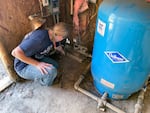Silvia Hernandez has been living in a small home near the outskirts of Boardman for the past ten years with her husband and 8-year-old child. Since her home is near the city limits, she has no access to public water services — just a private well for water.
When she moved in, her realtor told her the well water was safe to drink straight from the faucet, but she never felt comfortable drinking it that way.
And it’s a good thing she didn’t.
Recently, the local health department tested Hernandez’s well water for nitrates, a naturally occurring chemical that’s also a common ingredient in fertilizer. The results came in at nearly five times the federal safe drinking water limit.
When used properly, nitrates are beneficial nutrients that help crops grow. But when excess amounts of nitrates seep down into the groundwater — the primary source of drinking water in Morrow and Umatilla counties — they become pollutants that can cause respiratory infections, thyroid dysfunctions and bladder cancer.

Morrow County Commissioner Jim Doherty is showing Silvia Hernandez her well water test results for nitrates which exceeded the federal safe drinking water limits by nearly five times on April 15, 2022.
Monica Samayoa / OPB
When Hernandez saw her results, she was left speechless. She was not aware that homeowners like herself needed to maintain their private wells to flush out harmful contaminants, so she never had a filter system that would have removed excess nitrate.
For a while, Hernandez used her well water for cooking, but lately she has been buying bottled water for that.
“About 10 gallons a week,” she said in Spanish. “We use the well water for everything else, like showering, laundry and washing dishes.”
Nitrates seeping through the soil and contaminating the groundwater is a national problem that’s often seen downstream from large agricultural operations and industrial food processors. In Morrow and Umatilla counties, where both of those industries play a big role in the economy, widespread groundwater contamination has steadily increased over the last 30 years, according to data collected by the Oregon Department of Environmental Quality.
The agency says irrigated agriculture makes up the majority of excess nitrate to the area’s groundwater. But federal and state governments rely on voluntary measures to reduce nitrate contamination from agriculture.
A committee made up of state and local governments, farmers and Oregon State University has been working for decades to reduce nitrate contamination in the Lower Umatilla Basin groundwater, but the problem persists and continues to put the area’s drinking water at risk.
Critics say it’s only getting worse because federal and state agencies are relying too heavily on voluntary measures while falling behind on enforcement of pollution permits. Earlier this year, DEQ flagged two major wastewater violations that added more than 254 tons of excess nitrate to the area’s groundwater over a six-year period.
With no clear path to solving the problem, nitrates are continuing to affect local communities, especially private well owners like Hernandez.
30-year effort falls short
Morrow County Commissioner Jim Doherty has been visiting homes in the outskirts of Boardman to collect drinking water samples from private wells for nitrate testing. He’s checking to see how many homes have water filter systems installed and telling people who don’t know about the high nitrate issue.
Doherty took about 15 samples from one neighborhood and noted only about half of the homes had filter systems for their wells that would protect them from drinking contaminated water. He said the test results were astounding.
“Every single one of them was high enough to cause horrific health concerns, and I have a feeling if I test another hundred, 90% of them are going to be the same,” he said.
About 30 years ago, Doherty was part of a committee that was formed to address the nitrate contamination problem in the Lower Umatilla Basin Groundwater Management Area after groundwater samples from 1989 showed the area exceeded the federal safe drinking water standard. According to the Environmental Protection Agency, nitrate levels exceeding 10 milligrams per liter in drinking water can cause serious health risks if consumed.

Silvia Hernandez's private well on the outskirts of Boardman, Oregon on April 15, 2022
Monica Samayoa, Monica Samayoa / OPB
The Lower Umatilla Basin Groundwater Management Area groundwater committee is made up of members representing state agencies, local governments, water districts and farmers. Their task was to identify what’s causing the high levels of nitrate in the groundwater and develop recommendations for reducing them.
Early on, DEQ sampled nearly 200 wells in the area to better understand the extent of the groundwater contamination. Using that data, the committee identified five sources of contamination: irrigated agriculture, food processing wastewater, animal operations like dairies and feedlots, sewage from septic tank systems and the U.S. Army Umatilla Chemical Depot’s bomb washout lagoons.
But without regulatory power, the committee could only go so far. Doherty, who is a cattle rancher and was representing both ranchers and farmers at the time, said he found no one was taking responsibility for their contributions of nitrate. At the time, he said, everyone on the committee including himself was trying to protect the agricultural and industrial business interests.
“I was on it for a half a dozen years,” Doherty said. “And we didn’t do anything other than try and float it past DEQ and try and talk nice to them and keep them from coming out here, so we could continue doing what we’re doing.”
State regulators face criticism
Doherty, who stepped away from the committee and is now a commissioner in Morrow County, said he doesn’t know why state agencies still haven’t created tougher regulations, especially as nitrate levels have increased.
Both the Oregon Department of Agriculture and DEQ say they’re doing what they can to reduce the nitrate problem.
DEQ issues wastewater permits for industrial facilities like food processing plants to limit the amount of nitrogen-rich wastewater they can apply to farmland, a common practice that can contribute to the contamination problem if it’s done in excess.
Doherty said DEQ should not have allowed entities like the Port of Morrow or food processor Lamb Weston to continually violate their wastewater permits at high rates year after year. The agency only became aware of the violations after each entity applied to renew their permits. The Port of Morrow received a $1.3 million fine — the second largest in state history — for violating its permit more than a thousand times over the course of four years.

The Port of Morrow's East Beach Facility, where Lamb Weston operates a potato processing facility in Boardman, Oregon on April 15, 2022.
Monica Samayoa / OPB
Doherty said the agency should have acted a lot sooner, and its lack of oversight is frustrating.
“They should have done that 30 years ago, 20 years ago, 10 years ago,” he said.
Newly appointed DEQ Eastern Region Administrator Shannon Davis said it’s a challenge when governments need to regulate an economic engine as big as these entities, which collectively, bring billions of dollars to the region and provide hundreds of jobs to residents. But she said she recognizes both the agency and the Port of Morrow could have done a lot better in preventing excess nitrate from contaminating the groundwater.
“I know that DEQ is holding itself accountable, from the director on down, holding ourselves accountable to what our regulatory authority is, and that’s to issue really good permits and to also take enforcement actions where those are needed,” Davis said.
Because nitrate is a naturally occurring chemical, Davis said, it’s not a regulated substance, which creates bigger challenges in understanding who can make what decisions and what methods can be used to clean it up.
“So we all have our little pieces in it but we don’t understand what everybody else’s pieces are, and we don’t understand what the gaps are, so we have a lot of work ahead of us,” she said.
For example, the Oregon Department of Agriculture is the lead agency for regulating dairy farms or CAFOs — Concentrated Animal Feeding Operations — by issuing water pollution permits. The agency also implements agricultural water quality plans and rules to prevent and control water pollution from from CAFOs and farmers who irrigate and apply nutrients to farmland outside of DEQ’s wastewater irrigation permits.
ODA’s Agricultural Water Quality Program Manager Marganne Allen said her agency supports voluntary efforts by agricultural industries and then puts up a regulatory backstop if needed.
“Ultimately, it’s about a voluntary effort first,” she said. “And where [we] either [are] not achieving what we want, or if there’s individuals that we are able to identify with compliance issues, then we would look to a compliance approach after that.”
If the agency receives a formal written complaint of an alleged occurrence of agricultural pollution, the agency may conduct an investigation. ODA said they have not received any irrigated agriculture complaints in the Lower Umatilla Basin area.

A pie chart from the Oregon Department of Environmental Quality shows the state's estimates of the sources of nitrogen leaching into the groundwater in the Lower Umatilla Basin Groundwater Management Area.
Oregon Department of Environmental Quality / Oregon Department of Enviromental Quality
But according to data from DEQ, the number one contributor of nitrate contamination in the region is irrigated agriculture. It accounts for nearly 70% of the estimated nitrates that leach into the groundwater. And yet, it’s unclear how the current monitoring system from both DEQ or ODA accounts for the influence of individual farms.
A balancing act for farmers
Fourth-generation farmer Jake Madison owns about 17,000 acres in Echo, Oregon. He grows a range of crops on his farm including grass seeds, onions, potatoes and wheat. He’s facing many challenges as a farmer — from climate change to skyrocketing fertilizer costs and water shortages.

Fourth generation farmer Jake Madison stands on his farm located in Echo, Oregon on April 15, 2022. In order to reduce nitrates in the groundwater, Madison is using science and technology to better understand what's in his soil and how to best manage it for his crops.
Monica Samayoa / OPB
He said he understands that irrigated agriculture or farmers like himself get a bad reputation because of past generations. Historically, he said, farmers were planting and applying all the fertilizer they could on their farms to get the highest crop yield. He said that could be one of the many reasons why there are such high levels of nitrate found in the area today.
So, Madison turned to science to better understand his land and to make sure he’s using every bit of nutrients, including fertilizer and water, as efficiently as possible.
“Those are two precious resources, natural resources that are extremely valuable and we can’t afford to waste from a sustainability standpoint or from a financial standpoint or from a community health standpoint,” he said.
For every crop that he grows, Madison collects soil samples to determine how much nitrate is already in the soil at the starting point for the next crop. Once it’s planted, he continues to collect soil samples every two weeks until the crop is harvested.
“It’s scheduled, and it’s metered, and it’s monitored because we can’t afford to waste it,” he said. “We manage the crap out of it.”
Madison said it’s a lot of work, but it helps him understand what’s already in his soil, and it gives him some assurance that he’s not contributing to groundwater contamination. He and his father were previously on the Lower Umatilla Basin groundwater committee, and his brother is on the committee now. But he said, there continues to be disagreement about what data should be used to determine how much nitrate is in the groundwater and soil and how data should be used to create regulations.
“Nobody’s come together and said, ‘All right, we’re done pointing fingers, let’s start talking about real solutions,’ and that’s what it’s going to take,” Madison said. “That’s why it’s been 30-50 years of nothing happening. It can’t be everybody pointing fingers at farmers or everybody pointing fingers at industry or everybody pointing fingers at regulators.”
Nitrate levels increasing
Annie and Adam Philpott purchased their home in the outskirts of Boardman in the spring of 2018. About a year and a half after moving into their new home, the Philpotts decided to refinance with a new mortgage company. The new lender required a water quality test from their private well to ensure the groundwater has not exceeded safe drinking water limits.
But when Adam Philpott submitted the first test, the nitrate levels were at 17 milligrams per liter. After using chlorine tablets and flushing his system several times, he submitted a second test that came back at 20 milligrams per liter.
“The more we flushed it, the more nitrates we kept getting,” he said.
Because his well levels came back too high, he was not able to refinance his home — even though he has a filter system for his kitchen sink that removes excess nitrates.

Annie Philpott says her family's private well needs to be replaced, but they don't have the money to replace it. The Philpott's were hoping to refinance their home but did not qualify after their well system tested too high for nitrates.
Monica Samayoa / OPB
He contacted his current lender but because he could not pass the water quality test, he wasn’t able to get the type of loan he wanted that would have allowed him to take cash out to pay off debt.
“I have a lot of equity in my property,” he said. “It would be really nice to use that to pay off debt or buy a vehicle or whatever, but I can’t, it’s just got to stay there and just be what it is.”
Philpott said if he wanted to sell his home, he’d have the same problem. No lender would be able to finance anyone interested in his home until he replaces his well system, which he said could cost more than $5,000.
“That’s money I don’t have, so it’s not going to happen anytime soon,” he said.
Since the groundwater contamination problem in Morrow and Umatilla counties was first identified in 1989, well testing in the region has actually decreased.
Of the original 198 wells that were tested to understand the extent of the groundwater contamination, only 31 wells are still routinely tested. In the early 90s, those wells were tested twice a month, but to save money, DEQ reduced testing from six to four times a year.
Despite ongoing efforts to address the problem, there’s actually been a 55% increase in nitrates contaminating groundwater in Morrow and Umatilla counties since 1997, according to the Lower Umatilla Basin committee’s 2020 report. About 30% of the wells tested exceeded the federal limit for safe drinking water.
This prompted a coalition of environmental groups to file a petition in early 2020 asking the Environmental Protection Agency to take emergency action under the Safe Drinking Water Act in Umatilla and Morrow counties.
“We’re asking EPA to use those emergency powers to come in and effectively take emergency action in the form of potentially enforcement actions, providing clean and free drinking water, conducting investigations, requiring more groundwater monitoring and establishing more transparency about what people may be exposed too,” Food and Water Watch Legal Director Tarah Heinzen said.
The petition also calls for prohibiting any new CAFOs from opening in the region until nitrate concentrations in the area fall below the federal safe drinking water limit.
Heinzen said under the Safe Drinking Water Act, the EPA can step in when a state is not addressing a dangerous public health problem and when it can demonstrate that an imminent and sustainable endangerment does exist.
Despite having been two years since the petition was filed, Heinzen said they’ve only seen the state double down on its voluntary approach.
“That to us isn’t the state doing its job or taking this problem seriously,” she said. “And we’d like EPA to respond accordingly.”
Long way to go
The Lower Umatilla Basin groundwater committee still has a long list of goals for addressing the nitrate problem. Those include securing more funds for soil and water testing, minimizing the amount of nitrate that is applied to farmland to reduce what is leaching into groundwater, working with researchers at Oregon State University to study the problem and creating better voluntary practices that farmers can follow.
DEQ’s Davis said she hopes the groundwater studies will help the agency set new limits for how much nitrate can be applied to farmland by entities like the Port of Morrow and potato processor Lamb Weston.
“Once you can get the source where the contamination is coming from, it’s easier to be able to understand what the contamination is,” Davis said. “But I think we need to understand the water flows better than we do, the hydrogeology.”
Most of the committee’s current goals were set to begin in 2020 — thirty years after the committee was first formed. One of the goals is to find funding for the United States Geological Survey to develop a model of the Lower Umatilla Basin that will help identify where nitrate contamination is coming from. But that isn’t scheduled to start until 2025.
ODA’s Allen said some of the committee’s plans haven’t happened or have been delayed because of a lack of funds.
“We have a new plan,” she said. “We’re trying to implement it with our partners the best that we can and move forward.”
For Jim Doherty, time is of the essence. He remembers when he first moved to Boardman in the 1970s, he did not have to buy water filters for the well water at his home. He’s worried he’ll continue to encounter homes that don’t have filters, or if they do, they’re broken and need to be replaced.
He said the state should be providing filters for private well owners, so people don’t have to buy them. And he said he’s hopeful that state agencies might enforce tougher permits and issue bigger fines for water pollution violations that will help to reduce the nitrate contamination and break through any resistance from agricultural and industrial businesses.
“I think there’s the forces from the DEQ coming down and from the EPA coming down,” Doherty said. “And there’s forces from the bottom up in the community that I think are not going to allow it this time.”
